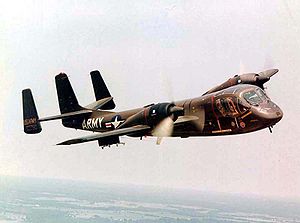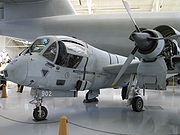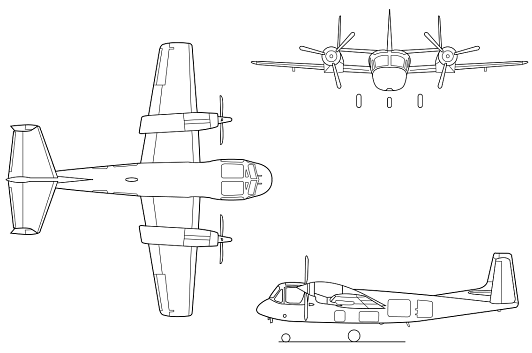Grumman OV-1 Mohawk Video - Documentary
More Grumman OV-1 Mohawk Videos 1 2 3 - Grumman OV-1 Mohawk Pictures
|
|
|
|
 |
Role - Light attack and observation aircraft
Manufacturer - Grumman
First flight - April 14, 1959.
Introduced - October 1959
Primary user - United States Army
Number built - 380
The Grumman OV-1 Mohawk is an armed military observation and attack aircraft, designed for battlefield surveillance and light strike capabilities. It is of twin turboprop configuration, and carried two crewmembers with side by side seating. The Mohawk was intended to operate from short, unimproved runways in support of Army maneuver forces.
Development
The prototype (YAO-1AF) first flew on April 14, 1959. The OV-1 entered production in October 1959 and served the U.S. Army in Vietnam and Operation Desert Storm. The Mohawk was removed from U.S. Army service in September 1996.
Over the years, the mission and the aircraft underwent many changes and roughly 380 were built over all variants. Mohawk variants included the JOV-1 [armed reconnaissance], OV-1A, [visual and photographic], OV-1B [visual, photographic, and side-looking radar (SLAR) pod], the OV-1C [visual, photographic, and infrared], and the OV-1D (SLAR pod and bigger wings), OV-1E [enlarged fuselage for more sensor operators or cargo], EV-1E [Special electronic intelligence installation] and RV-1E [advanced ELINT Reconnaissance]. A four-engined Model 134E with tiltwings and tail ducted fan for control for VTOL was proposed to the Army but not built. Model 134R was a tandem cockpit version offered to meet the LARA requirement, but the NA300 was chosen instead becoming the OV-10.
The Mohawk began as a joint Army-Marine program through the then-Navy Bureau of Aeronautics (BuAer), for an observation/attack plane that would outperform the Cessna L-19 Bird Dog. In June 1956, the Army issued Type Specificationn TS145, which called for the development and procurement of a two-seat, twin turboprop aircraft designed to operate from small, unimproved fields under all weather conditions. It would be faster, with greater firepower, and heavier armour than the Bird Dog, which had proved vulnerable during the Korean War. The Mohawk's mission would include observation, artillery spotting, air control, emergency resupply, naval target spotting, liaison, and radiological monitoring. The Navy specified that the aircraft must be capable of operating from small "jeep" escort class carriers (CVEs). The DoD selected Grumman Aircraft Corporation's G-134 design as the winner of the competition in 1957. Marine requirements contributed an unusual feature to the design. As originally proposed, the OF-1 could be fitted with water skis that would allow the aircraft to land at sea and taxi to island beaches at 20 kts. Since the Marines were authorized to operate fixed wing aircraft in the close air support (CAS) role, the mockup also featured underwing pylons for rockets, bombs, and other stores.
The Air Force did not like the armament capability of the Mohawk and tried to get it removed. The Marines did not want the sophisticated sensors the Army wanted, so when their Navy sponsors opted to buy a fleet oil tanker, they dropped from the program. The Army continued with armed Mohawks and developed cargo pods that could be dropped from underwing hard points to resupply troops in emergencies.
The radar imaging capability of the Mohawk was to prove a significant advance in both peace and war. The SLAR could look through foliage and map terrain, presenting the observer with a film image of the earth below only minutes after the area was scanned. In military operations, the image was split in two parts, one showing fixed terrain features, the other spotting moving targets.
In mid-1961, the first Mohawks to serve with U.S. forces overseas were delivered to the 7th Army at Sandhoffen airfield near Manheim, Germany. Before its formal acceptance, the camera-carrying AO-1AF was flown by Ralph Donnell on a tour of 29 European airfields to show it off before the U.S. Army field commanders and potential European customers. In addition to their Vietnam and European service, SLAR-equipped Mohawks began operational missions in 1963 patrolling the DMZ separating North and South Korea. Germany and France shown early interest in the Mohawk, and Grumman actually signed a license production agreement with the French manufacturer Breguet in exchange for American rights to the Atlantic maritime patrol aircraft.
The very nature of the joint Army/Marine program had forced design compromises that made the aircraft an expensive and, sometimes, openly resisted item in Army budgets. Orders for the OV-1 stopped in Fiscal 1964, and the controversy in the Pentagon over the armed Mohawk peaked with a 1965 directive that prohibited the Army from operating armed fixed wing aircraft. Operational success in Vietnam led to additional Mohawk orders in 1966, and by 1968, five surveillance companies were operating in Southeast Asia.
Last of the Mohawk versions to enter production was the OV-1D with more powerful T53-701 engines, improved avionics, and interchangeable mission pallets that make it possible to switch the aircraft from infrared to SLAR configuration in about an hour. The first four OV-1Ds were prototypes converted from earlier production airframes, and the first flew in 1969. These were followed by 37 new-build aircraft, the last of which was delivered in December 1970.
Starting in 1972, the Army National Guard (ARNG) began to receive the Mohawk, with the ARNG eventually operating has 13 OV-1Bs, 24 Cs, and 16 Ds serving with three units in Georgia and Oregon.
The OV-1 finally retired in Europe in 1992, then from Korea in September 1996, and finally in the US in 1996 because it had been superseded by newer systems, newer aircraft, and the evolution of the satellite. It was replaced by militarized version of the de Havilland DH-7 turboprop commuter airliner equipped with a SLAR system until E-8 J-STARS (Joint Surveillance Target Attack Radar System) aircraft, converted Boeing 707s with powerful side-looking radar, was available.
Variants
(Picture:
Carolinas Aviation Museum OV-1D Mohawk 874 in flight over Stanley County,NC 2006)
YAO-1 (YOV-1A)
Initial prototypes (9 built).
OV-1A (AO-1AF)
Daylight observation variant (64 built).
OV-1B (AO-1BF)
SLAR variant (101 built).
OV-1C (AO-1CF)
IR reconnaissance variant (169 built).
OV-1D
Consolidated sensor variant (37 new, 82 conversions).
JOV-1A
OV-1As & OV-1Cs fitted with armament (59 conversions).
(Picture: OV-1D 890 on final approach to Charlotte-Douglas International Airport in Charlotte, North Carolina)
RV-1C
Quick Look ELINT machines (2 conversions).
RV-1D
Quick Look II ELINT machine (31 conversions).
OV-1E
Prototype for unproduced modernized variant (one built).
Operators
Argentina
- Argentine Army
Germany
- West German Army
Israel
- Israeli Air Force
South Korea
- South Korean Air Force
United States
- US Army (withdrawn from service)
Survivors
Below is a list of flying and static Mohawks which survive:
Flying Mohawks
 (Picture:
OV-1D Mohawk at the Evergreen Aviation Museum in McMinnville, Oregon)
(Picture:
OV-1D Mohawk at the Evergreen Aviation Museum in McMinnville, Oregon)
- Argentine Army Aviation received 23 OV-1 in the 1990s. Ten are operational
and the rest are used for spare parts.
- American Wings Air Museum, Blaine, MN operates three Mohawks (64-14262, 68-15936, and 69-17021).
- Carolinas Aviation Museum flies two Mohawks to airshows (874 & 890)
- Cavanaugh Flight Museum flies one Mohawk
- American Warplane Museum in WI flies 2 or 3 Mohawks
- Army Aviation Heritage Foundation Hampton, GA Flies 631 "B" Model and 005 "d" Model http://www.armyav.org
Static Display Mohawks
- Fort Huachuca maintains a static display of an OV-1D Mohawk at the intersection of Hatfield and Irwin Streets
- The Pima Air & Space Museum lists an OV-1C Mohawk as a static display (located near Hangar #1)
- The Evergreen Aviation Museum displays a static OV-1D Mohawk in their hangar
- The United States Army Intelligence and Security Command Headquarters Building at Fort Belvoir, VA displays a static OV-1D.
- Valiant Air Command Warbird Museum, Titusville, Florida
- Hunter Army Airfield, Savannah, Georgia displays a static OV-1D dedicated to former crews of the 224TH Military Intelligence Battalion (Aerial
Exploitation)
- The 1st Cavalry Division Museum, Fort Hood, Texas displays a static OV-1D as part of the outdoor exhibit.
- The US Army Aviation Museum at Fort Rucker, Alabama displays a static OV-1D as part of the outdoor exhibit on Red Cloud Avenue
Specifications (OV-1D)
General characteristics
 - Crew: Two: pilot, observer
- Crew: Two: pilot, observer
- Length: 41 ft 0 in (12.50 m)
- Wingspan: 48 ft 0 in (14.63 m)
- Height: 12 ft 8 in (3.86 m)
- Wing area: 360 ft² (33.4 m²)
- Empty weight: 11,760 lb (5,330 kg)
- Max takeoff weight: 18,110 lb (8,215 kg)
- Powerplant: 2× Lycoming T53-L-701[1] turboprops, 1,400 shp (1,044 kW) each
Performance
- Never exceed speed: 370 knots (425 mph)
- Maximum speed: 305 mph (490 km/h)
- Range: 945 mi (1,520 km)
- Service ceiling: 25,000 ft (7,620 m)
- Rate of climb: 3,450 ft/min (17.5 m/s)
See also
Comparable aircraft
- FMA IA 58 Pucará
- OV-10 Bronco
- SOKO J-20 Kraguj
References
1. Grumman OV-1 Mohawk
The initial version of this article was based on a public domain article from Greg Goebel's Vectorsite.
- OV-1 Mohawk Walk Around (Neubeck), Squadron/Signal Publications (2007)
Living Warbirds: The best warbirds DVD series.
Source: WikiPedia